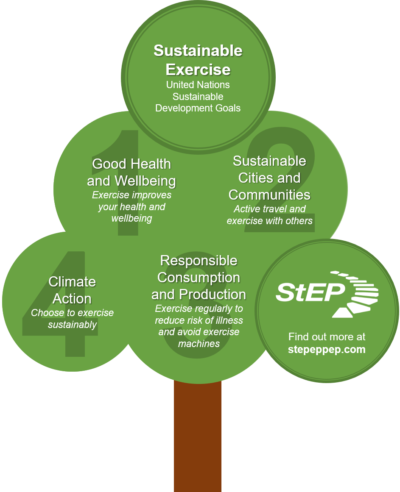Why Sustainable Exercise is Important.
What is sustainable exercise?
Sustainable exercise ensures both your exercise is regular and has minimal environmental impact. Therefore, sustainable exercise is essential for your own physical and mental health and well-being, as well as for the environment around you.
Health Benefits
There are many evidenced benefits of exercise spanning from reduced risk of major illnesses, such as cancer and heart disease to improved mood and sleep quality.
Sustained physical activity can decrease your risk of a remarkable amount of physical and mental health conditions. For example, regular physical activity reduces your risk of cardiovascular disease by 30%, type 2 diabetes by up to 40% and hip fractures by up to 68%.
Regular exercise also impacts your mood and cognition by stimulating your brain to release chemicals, such as the mood-elevating neurotransmitter serotonin. The speed at which you fall asleep and the quality of your sleep are also improved by daily exercise, which will raise your mood and concentration levels for the next day.
Our modern lives have become more and more sedentary with the use of cars for short journeys, manual labour being replaced by machines and sitting in front of the TV. Therefore, sustainable exercise is an increasingly important part of our routine. 25% of England’s population do less than 4 minutes of moderate exercise every day. If they would increase this by a daily 10 minutes, their life expectancy would increase by a shocking 2-3 years.

Environmental Benefits
Sustainable exercise has both short term and long term impacts on the environment.
Sustainable exercise will help to achieve some of the UN Sustainable Development Goals, such as:
- Goal 3 – Good Health and Well being
- As explained above in Health Benefits
- People who exercise are more likely to adopt a healthy diet, which includes the consumption of more fruits, vegetables and grains which can often be locally sourced
- Goal 11 – Sustainable Cities and Communities
- By exercising together, sustainable communities will be created
- Through active travel, cities will become more sustainable due to a decrease in transport pollution
- Goal 12 – Responsible consumption and production
- Sustainable exercise will decrease consumption of energy, for example energy to power vehicles/ exercise machines.
- Walking, running or cycling outdoors, in contrast to driving to the gym, leads to a marked reduction in fossil fuel consumption and pollution
- Regular exercise will reduce the consumption of materials and energy needed to treat illnesses that could have been prevented by regular exercise
- Goal 13 – Climate action
- Actively choosing sustainable exercise prevents climate breakdown

Your Next Steps
Sustainable exercise is beneficial to both health and well-being, and the environment. There are many health benefits to be gained from physical activity including reduced risk of developing major health conditions, improved mood and increased longevity. Environmentally, sustainable exercise can help to reduce the consumption of resources, develops sustainable cities and communities and helps to mitigate climate change.
If you would like to become involved in sustainable exercise, sign up to our mailing list and check out how to reduce your carbon footprint while you exercise.






Leave A Comment